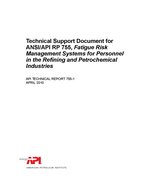Click here to purchase
This document identifies and explains the scientific and operational issues considered during the preparation of RP 755. By providing the reasoning behind the specific wording in the RP755 document, this document supports each key statement in RP 755 in sequence so that it can be used in parallel with the RP 755 text. To make this document accessible and manageable, key scientific sources and references are provided to help readers gain access to the scientific literature.
Fatigue Risk Management Systems (FRMS) have emerged and been widely recognized as a more effective approach to managing and mitigating employee fatigue risk in the 24/7 workplace. The core feature of the FRMS is that it is a data-driven, risk-informed, safety performance-based system. The FRMS implementation process first identifies all sources of fatigue risk in the business operation, then introduces mitigating policies, technologies, and procedures to reduce the risk, and most importantly then maintains them in a proactively-managed continuous improvement system. The history of FRMS was recently summarized.
This method represents a significant step change from the traditional approaches of either relying on maximum limits to hours of work or minimum limits to hours of rest (variously called Hours of Service, Work-Rest Rules, Working Time Directives), or adopting intermittent or piece-meal solutions (e.g. a fatigue training program or a shift schedule redesign), depending on the interests and initiative of local site managers.
One essential feature of FRMS is that it is a system meant to be improved upon on a regular and continuous basis. It is not a set of guidelines designed for one-time compliance, but instead provides a framework that will evolve over time, driven by the collection of data on fatigue risk and fatigue outcomes (e.g. fatigue-related incidents).
Product Details
- Edition:
- 1st
- Published:
- 04/01/2010
- Number of Pages:
- 49
- File Size:
- 1 file , 750 KB
- Product Code(s):
- K755101, K755101, K755101
- Note:
- This product is unavailable in Cuba, Iran, North Korea, Syria
